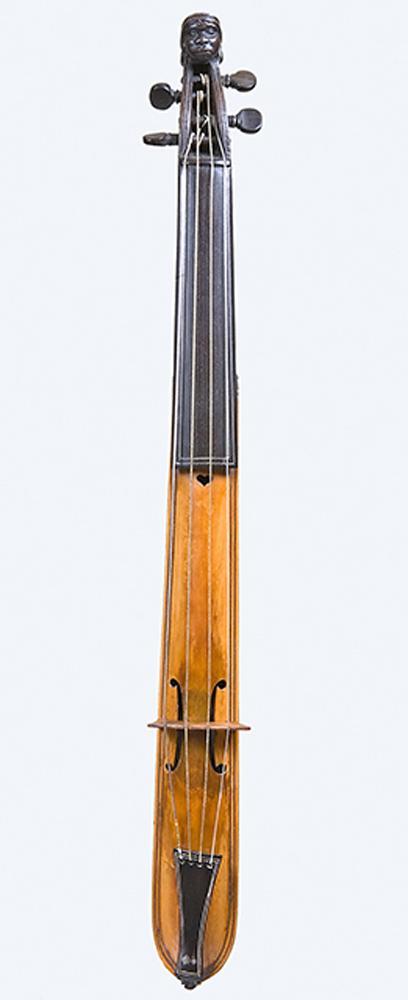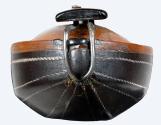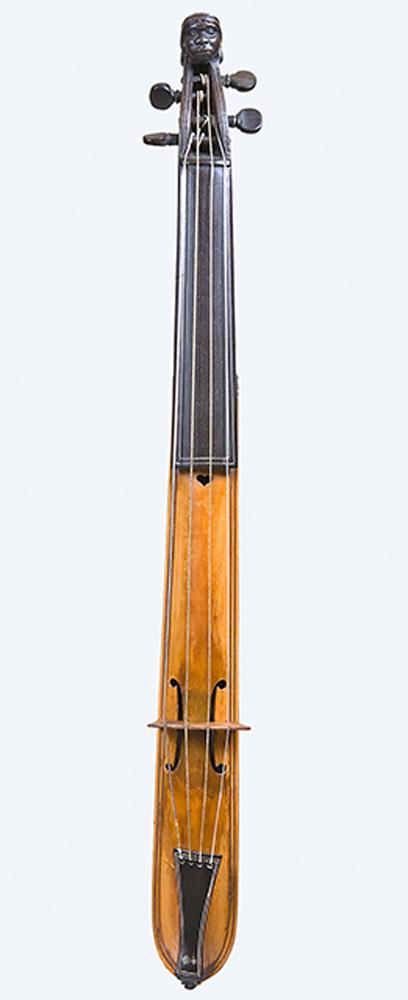Advanced Search
Bowed Strings
Pochettes and Kits
Pochette
Alternate name:Kit
Alternate name:Dancing master's fiddle
Maker: Joachim Tielke
Date: 1671
Place Made:Paris, France, Europe
Place Distributed:Hamburg, Germany, Europe
Serial No: none
SignedWritten in black ink on paper label: Joachim Tielke / in Hamburg i671
DescriptionAlthough this pochette bears a handwritten label of the renowned maker, Joachim Tielke (Hamburg, Germany, 1671), it may actually have been made in Paris by the prolific pochette maker, Jacques Regnault. Tielke researcher, Friedemann Hellwig, has suggested that Regnault may have been commissioned by Tielke to produce high-end pochettes for sale in his shop. Without a doubt, the instrument meets Tielke's standards for highly decorative and refined workmanship. The back, neck, pegbox, and humanoid finial of the pochette are all carved from one piece of ebony, with an added cypress belly. Delicately twisted silver wire decorates the pochette's back, neck, pegbox, fingerboard, carved head and ebony tailpiece. A tiny heart, carved into the belly just below the fingerboard, adds yet another decorative element to this delicate, 17th-century instrument.
Top: one-piece light hardwood top, possibly boxwood
Back, sides, neck, and head: one-piece ebony; five facets on back with flat-hammered double twisted silver wire inlay around edges; head terminates Moorish head with double twisted silver wire inlay
Purfling: flat-hammered double twisted silver wire around edges
Varnish: none
Decoration: flat-hammered double twisted silver wire inlaid throughout body and fittings; carved Moorish head
Fingerboard: ebony inlaid around edges with flat-hammered double twisted silver wire; wedge-shaped; relatively flat profile
Nut: ebony
Tailpiece: ebony inlaid around edges with flat-hammered double twisted silver wire; tailgut passes through holes drilled in face
Tailgut: silver wire; hammered ends to hold on tailpiece
Pegs: four ebony with slightly concave heads
Saddle: ebony; set into top
Endpin: ebony; integral with body
Soundholes: elongated c-shape with notches; small heart cut in top just below end of fingerboard
Top: one-piece light hardwood top, possibly boxwood
Back, sides, neck, and head: one-piece ebony; five facets on back with flat-hammered double twisted silver wire inlay around edges; head terminates Moorish head with double twisted silver wire inlay
Purfling: flat-hammered double twisted silver wire around edges
Varnish: none
Decoration: flat-hammered double twisted silver wire inlaid throughout body and fittings; carved Moorish head
Fingerboard: ebony inlaid around edges with flat-hammered double twisted silver wire; wedge-shaped; relatively flat profile
Nut: ebony
Tailpiece: ebony inlaid around edges with flat-hammered double twisted silver wire; tailgut passes through holes drilled in face
Tailgut: silver wire; hammered ends to hold on tailpiece
Pegs: four ebony with slightly concave heads
Saddle: ebony; set into top
Endpin: ebony; integral with body
Soundholes: elongated c-shape with notches; small heart cut in top just below end of fingerboard
DimensionsTotal length: 407 mm
Total length without endpin: 401 mm
Top length: 253 mm
Top width: 27-36 mm
Rib height: 7-19 mm
Stop length: 147 mm
Vibrating string length: 233 mm
Neck length (bottom of nut to ribs): 87 mm
Total length without endpin: 401 mm
Top length: 253 mm
Top width: 27-36 mm
Rib height: 7-19 mm
Stop length: 147 mm
Vibrating string length: 233 mm
Neck length (bottom of nut to ribs): 87 mm
ProvenancePreviously owned by William E. Hill & Sons, London, England. Purchased in 1988 from Bernhard von Hünerbein, Cologne, Germany.
Terms
Credit Line: Board of Trustees, 1988
Not on view
Published ReferencesAn Illustrated Catalog of the Music Loan Exhibition Held . . . by the Worshipful Company of Musicians at Fishmongers' Hall, June and July 1904 (London: Novello, 1909), p. 160.
Georg Kinsky, Musikhistorisches Museum von Wilhelm Heyer in C"ln, Katalog, Vol. 2 (Leipzig: Breitkopf & Härtel, 1912), p. 645.
Günther Hellwig, "Joachim Tielke," Galpin Society Journal 17 (1964), p. 34.
Anthony Baines, European and American Musical Instruments (London: Batsford, 1966), plate 43, p. 10.
Gunther Hellwig, Joachim Tielke (Frankfurt: Verlag das Musikinstrument, 1980), pp. 52, 73-74, 120, 139-140.
Made for Music: An Exhibition to Mark the 40th Anniversary of the Galpin Society for the Study of Musical Instruments (Amersham: Halstan & Co., 1986), p. 43, plate 11.
"1988 Acquisitions at USD Music Museum," Newsletter of the American Musical Instrument Society 18, No. 1 (February 1989), p. 9.
"Recent Acquisitions Await New Galleries," Shrine to Music Museum Newsletter 16, No. 3 (April 1989), p. 2.
Shrine to Music Museum Newsletter 17, No. 3 (April 1990), p. 4.
Paul R. Laird, "That Gut Feeling: The World of Early Strings—The Shrine to Music Museum," Continuo (June 1996), p. 16.
Friedemann Hellwig, "Hamburg and Paris: Joachim Tielke's Pochettes," Galpin Socity Journal 62 (2009), pp. 183-190.
Georg Kinsky, Musikhistorisches Museum von Wilhelm Heyer in C"ln, Katalog, Vol. 2 (Leipzig: Breitkopf & Härtel, 1912), p. 645.
Günther Hellwig, "Joachim Tielke," Galpin Society Journal 17 (1964), p. 34.
Anthony Baines, European and American Musical Instruments (London: Batsford, 1966), plate 43, p. 10.
Gunther Hellwig, Joachim Tielke (Frankfurt: Verlag das Musikinstrument, 1980), pp. 52, 73-74, 120, 139-140.
Made for Music: An Exhibition to Mark the 40th Anniversary of the Galpin Society for the Study of Musical Instruments (Amersham: Halstan & Co., 1986), p. 43, plate 11.
"1988 Acquisitions at USD Music Museum," Newsletter of the American Musical Instrument Society 18, No. 1 (February 1989), p. 9.
"Recent Acquisitions Await New Galleries," Shrine to Music Museum Newsletter 16, No. 3 (April 1989), p. 2.
Shrine to Music Museum Newsletter 17, No. 3 (April 1990), p. 4.
Paul R. Laird, "That Gut Feeling: The World of Early Strings—The Shrine to Music Museum," Continuo (June 1996), p. 16.
Friedemann Hellwig, "Hamburg and Paris: Joachim Tielke's Pochettes," Galpin Socity Journal 62 (2009), pp. 183-190.
Object number: 04542




















